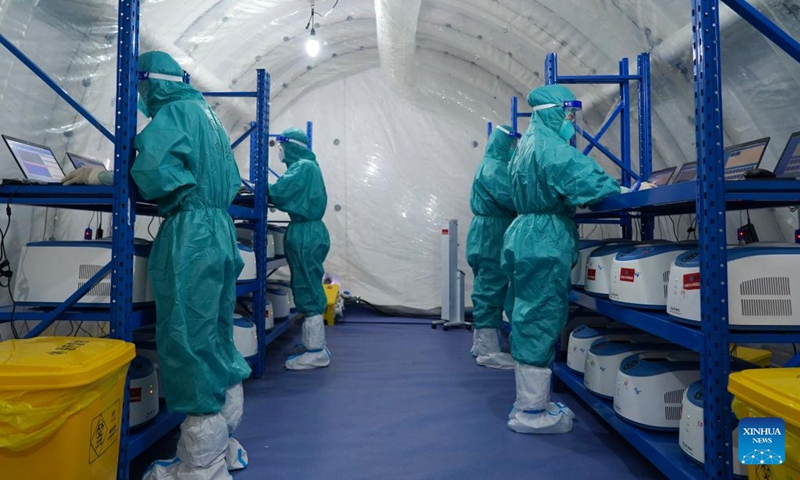
Medical workers work in an air-inflated testing lab in Chengdu, southwest China's Sichuan Province, Sept. 5, 2022. The city of Chengdu has built five air-inflated laboratories for COVID-19 nucleic acid testing, providing a daily maximum testing capacity of 250,000 tubes.(Photo: Xinhua)
Virologists and disease prevention and control departments denied reemergence of COVID-19 original variants and Delta in China, after concerns that the "old" variants have caused an increase in COVID infections and some of the most severe cases showed white lungs in their CT scan results.
Real-time dynamic monitoring on COVID-19 shows no Delta variant was found to be prevalent in China, and no Delta variant was found to recombine with Omicron variant, Xu Wenbo, director of Institute of Viral Diseases, Chinese Center for Disease Control and Prevention (China's CDC), said.
Since the beginning of December, China's CDC has completed the whole genome sequencing of 1,142 cases through sampling survey, and found that the Omicron variant strains of the subbranches BA.5.2 and B.7 are dominant strains in the country, and the two together accounted for more than 80 percent of all cases. The country also has seven subbranches of Omicron variants circulating, Xu noted.
Some claimed that some COVID-19 patients in Beijing and North China's Hebei Province have shown signs of white lungs in their CT scan results and the phenomenon may indicate that these cases were not infected with the Omicron variant but the original variant that was detected in Wuhan, triggering public concerns or even panic.
Coronavirus strains circulating in Beijing are the Omicron variant strains BF.7 branch and BA.5.2 branch. The prevalence of XBB, BQ.1 and other variants has not been found in the society, nor the prevalence of non-Omicron variants such as original strains and Delta strains, said Pan Yang from Beijing Municipal Disease Prevention and Control Center.
China has never stopped surveillance of domestic epidemic strains through whole genome sequencing, with no prevalence of Delta strain or the original strain being found. Whole genome sequencing technology can sequence more than 30,000 basic groups of the coronavirus one by one, and perform bioinformatics analysis based on the results, so that different mutations can be classified into corresponding subtypes, Tong Yigang, a virologist and the head of College of Life Science and Technology, Beijing University of Chemical Technology, told Science and Technology Daily.
To understand virulent epidemic strains in the very first time, the disease control and prevention departments will sample and sequence the strains that cause severe cases. The new guidance on instructing viral strains said that sentinel hospitals are set up in three selected cities in each Chinese province and they are required to conduct genome sequencing analysis on 15 emergency cases, 10 severe cases and all deaths and upload the result to China's CDC within one week.
Wuhan, for example, has three sentinel hospitals - Wuhan First Hospital, Wuhan Children Hospital and Jinyintan Hospital - whose data showed the dominant strain in the city is BA.5.2, Yang Xiaobing from Wuhan Center for Disease Control and Prevention said. These hospitals normally collect 20 samples of throat swabs weekly and starting from mid-December, the sample size has been increased to 40.
The term "white lung' is now being overused on the internet, because some patients are simply mistakenly called having a "white lung" though their symptoms are not that severe, experts noted.
"White lung" is a more serious manifestation of pneumonia with white image area reaching 70 to 80 percent of patient's lungs. Patients with this symptom actually account for a very low proportion, said Jiao Yahui, deputy head of Medical Policy and Administration Bureau under National Health Commission (NHC).
Clinical diagnosis from experiences of Liu Chuntao, a respiratory expert from West China Hospital, Sichuan University, also shows Omicron-infected patients with serious pneumonia are usually seen among seniors aged above 80, and patients under 50 years old with severe pneumonia in his ward account for a very small proportion.
Among hospitalized patients with the Omicron strain, the proportion of lung imaging lesions was about 13 to 32 percent, which was significantly lower than that of previously prevalent non-Omicron strains, according to data quoted by Yixuejie, a leading platform for medical insights and information in China.
Liu said that the onset of pneumonia can be six to seven days later than the early symptoms of COVID-19 like fever and cough. Senior patients should see doctors if they have difficulty in breathing or if oxygen saturation measured by a pulse oximeter is less than 93 percent.
Global Times




